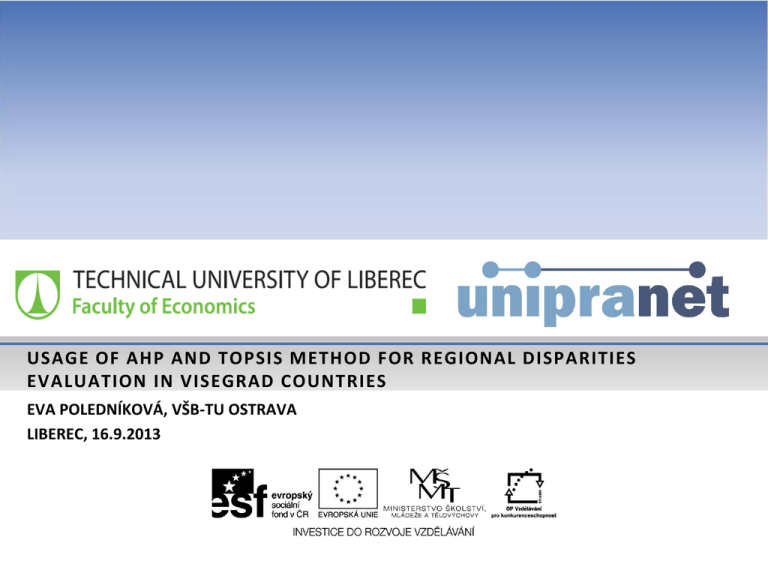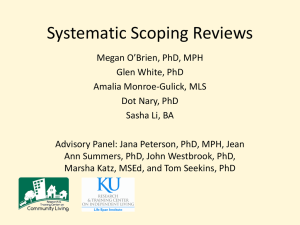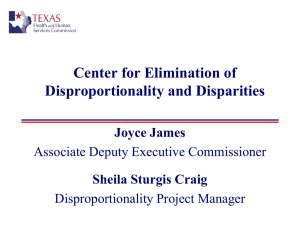usage of ahp and topsis method for regional disparities evaluation in
advertisement

USAGE OF AHP AND TOPSIS METHOD FOR REGIONAL DISPARITIES EVALUATION IN VISEGRAD COUNTRIES EVA POLEDNÍKOVÁ, VŠB-TU OSTRAVA LIBEREC, 16.9.2013 CONTENT 1. INTRODUCTION 2. THEORY OF REGIONAL DISPARITIES EVALUATION 3. METHODOLOGY OF PAPER 4. EMPIRICAL RESULTS 5. CONCLUSION 6. LITERATURE 1. INTRODUCTION The measuring of socio-economic disparities between regions is the main issues of regional economic research because they negatively affect the coherent, balanced development of the EU as well as the level of global EU performance and competitiveness. Regional disparities evaluation is impaired by a lack of integrated approaches and methodologies in the EU. The aim of the paper is to evaluate the regional disparities of socio-economic development in Visegrad Four (V4) countries in the period 2000-2010 using AHP and TOPSIS method. The paper should contribute to accept or reject the hypothesis that the main regional disparities exist between NUTS 2 regions with capital city (Praha, Bratislavský kraj, Mazowieckie, KözépMagyarország) and other regions in V4. 2.THEORY OF REGIONAL DISPARITIES EVALUATION Within European approach we recognize three types of disparities: economic, social and territorial. Most of the existing approaches to regional disparities evaluation use several indicators that are processed by simple or more sophisticated mathematical and statistical methods. More sophisticated methods are multivariate statistical methods, especially cluster analysis and factor analysis. Alternative and not broadly extended approach to regional disparities represents multicriteria decision-making methods (AHP, TOPSIS, SAW,VIKOR). The adequate indicators of regional disparities can be identified within the Reports on Economic, Social and Territorial Cohesion that evaluate the trends of disparities and cohesion in the EU. 3. METHODOLOGY OF PAPER Analytic hierarchy process (AHP) and Technique for Order Preferences by Similarity to an Ideal Solution (TOPSIS) method is applied to the evaluation of disparities between NUTS 2 regions in V4 in the year 2000, 2005, 2010. AHP is used to derive the weights of criteria that are subsequently inserted to weighted decision matrix in TOPSIS method. In using the AHP to model the problem, hierarchy representing the problem is needed, as well as pairwise comparisons to establish relation within the structure. Distances of regions to ideal solution and their final ranking can be obtained from the method TOPSIS. 3. METHODOLOGY OF PAPER GDP per capita (GDP); Disposable income of households (DI); Gross domestic expenditure on R&D (GERD); Employment rate (ER); Unemployment rate (UER); Persons aged 30-34 with tertiary education attainment (TE); Infant mortality rate (IM); Hospital beds (HB) 3. METHODOLOGY OF PAPER To determine the final weights of criteria, pairwise comparison in the context of AHP is applied to calculate weights of subcriteria with respect to the goal. After that criteria are pairwise compared against the subcriteria importance. The comparisons are taken from Saaty´s fundamental scale (1,3,5,7,9) which indicates how many times more important one element is over another element with respect to property to which they are compared to. Elements are scored according to author´s subjective preferences. 3. METHODOLOGY OF PAPER TOPSIS method is based on the choosing of the best alternative nearest to the ideal solution (with the shortest Euclidean distance) and farthest from the negative ideal solution. Firstly, we convert all the criteria so that all of them were either minimization or maximization. Second step is to calculate the normalized decision matrix rij. Third step is to calculate weighted normalized decision matrix. The following step includes the determination of the positive ideal solution (Hj) and the negative ideal solution (Dj) . Then, the separation from the ideal (di+) and the negative ideal solutions (di-) between alternatives is calculated. Last step include the calculation of the relative closeness ci to the ideal solution and rank the alternatives in descending order. 4. EMPIRICAL RESULTS According to final calculated weights of criteria, indicators GDP per capita, disposable income and unemployment rate have the highest importance in evaluation of regional disparities and the level of region´s development. 4. EMPIRICAL RESULTS 4. EMPIRICAL RESULTS 5. CONCLUSION With regard to the shortest relative closeness to ideal solution, the most developed regions with capital city - Praha, Bratislavský kraj, Közép-Magyarország and Mazowieckie are ranked on the first four position. On the contrary Polish regions Podkarpackie, Świętokrzyskie, WarmińskoMazurskie and Slovak region Východné Slovensko recorded the farthest distance to ideal solution and they are average ranked in last position. Region´s ranking also indicates the substantial differences between Czech regions and other regions. The results partially confirm the hypothesis; main regional disparities in V4 have persisted between regions with capital cities and other regions since year 2000. The dominance of capital cities results from more intensive integration into the world economy. Capital cities are main administrative centres, where the great mass of public institutions and the private sector is concentrated (corporate headquarters, central administrative authorities, universities, etc.). On the other hand, it is necessary to take into account the statistical effect that can overvalue some indicators of economic performance. Presented MCDM methods can be considered as suitable and interesting alternative for quantitative regional disparities evaluation. 6. LITERATURE EUROPEAN COMMISSION. Fifth Report on Economic, Social and Territorial Cohesion. Investing in Europe’s future. Luxembourg: Publications Office of the European Union, 2010. ISBN 978-92-79-16978. DAI, X., ZHANG, J. The TOPSIS Analysis on Regional Disparity of Economic Development in Zhejiang Province. CanadianSocial Science, 7 (5), 2011, p. 135-139. Available from: <http:// www. cscanada.net/index.php/css/article/view/j.css.1923669720110705.115>. KUTSCHERAUER, A. et al. Regional disparities. Disparities in the Regional Development, their Concept, Identification and Assessment. Ostrava: VŠB-TU Ostrava. 2010. ISBN 978-80-248-2380-5. MELECKÝ, L.; SKOKAN, K. EU Cohesion and Its Evaluation in the Case of Visegrad Four Countries. In Liberec Economic Forum 2011. Proceedings of the 10th International Conference. Liberec: Technical University of Liberec, 2011, p. 314 – 326. ISBN 978-80-7372-755-0. MOLLE, W. European Cohesion Policy. London: Routledge, 2007. ISBN 978-0-415-43812-4. OZTURK, D.;BATUK, F.Technique for order preference by similarity to ideal solution (TOPSIS) for spatial decision problems.[online]. 2011 [cit. 2013-03-29]. Available from: <http://www.isprs.org/proceedings/2011/Gi4DM/PDF/PP12.pdf>. SAATY,T.;VARGAS, G. L.Models, Methods, Concepts and Applications of the Analytic Hierarchy Process. New York: Springer Science+Business Media, 2012. ISBN 978-1-4614-3596-9. SOARES, O. J., MARGUES, M.M.L., MONTEIRO, C.M.F. A multivariate methodology to uncoverregional disparities: A contribution to improveEuropean Union and governmental decision. EuropeanJournal of Operational Research, 2003, p. 121-135.ISSN 0377-2217. •SHIHA, H.S.;SHYURB, H.J.;LEE, E. S.An extension of TOPSIS for group decision making.Mathematical and Computer Modelling 45, 2007, p. 801–813. ISSN 0895-7177. TVRDOŇ, M.Cohesion, convergence and regional disparities: The case of European Union.WSEAS Transactions on Business and Economics9(2), 2012, p. 89–99.E-ISSN 2224-2899. TZENG, G. H.;HUANG, J.J. Multiple attribute decision making: methods and applications. Boca Raton: CRC Press, 2011. ISBN 978-1-4398-6158-5. THANK YOU FOR YOUR ATTENTION! eva.polednikova@vsb.cz











